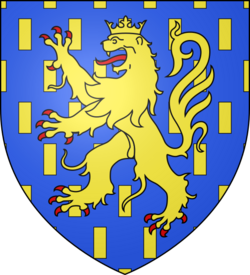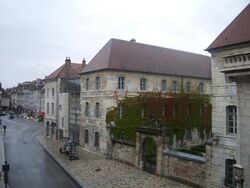University of Franche-Comté
Topic: Organization
 From HandWiki - Reading time: 5 min
From HandWiki - Reading time: 5 min
Université de Franche-Comté | |
 | |
| Latin: Universitas Liberi Comitatus | |
| Type | Public university |
|---|---|
| Established | 1423 (in Dole, Jura) 1621 (in Besançon) |
| Rector | Marie-Christine Woronoff-Lemsi |
Academic staff | 1,200 (1,500 professional tutors) |
Administrative staff | 850 |
| Students | 28.994 (2020) |
| Location | Besançon , |
| Affiliations | University of Burgundy - Franche-Comté |
| Mascot | Lynx |
| Website | http://www.univ-fcomte.fr/ |
 | |
The University of Franche-Comté (UFC) is a pluridisciplinary public French university located in Besançon, Franche-Comté, with decentralized campuses in Belfort, Montbéliard, Vesoul and Lons-le-Saunier.
It is a founding member of the community of universities and institutions University of Burgundy - Franche-Comté (COMUE UBFC), headquartered in Besançon and which federates universities and other higher learning institutes in the Bourgogne-Franche-Comté region.
With 28 research labs, 667 PhD students and 788 research professors in 2016–2017, the University of Franche-Comté is well represented in the research community. It collaborates with many organizations (University Hospital of Besançon, CNRS, INSERM, CEA, etc.).
It has about 29,000 students, including nearly a third of scholarship students and 12% of foreign students. Its Centre for Applied Linguistics (CLA) is one of the world's leading schools for teaching French as a foreign language and French linguistics.
History
The university was founded in 1423 in Dole, at that time in the Duchy of Burgundy.[1] It was moved to Besançon in 1691 as Dole was being punished for having resisted too long against the king of France Louis XIV during his conquest of the region.[1]
Research centres
The Centre for Applied Linguistics (CLA) of the University of Franche-Comté ranks among the top language teaching institutions in the world. The CLA has research contacts in more than 110 countries, and partners with the French Ministry of Education and the Ministry of Foreign Affairs.[2]
The Centre of Distance Teaching (CTU) allow to people who are working to continue to study in different matters like history, informatics, mathematics, AEG, etc.
Much of the international visibility in pure and applied science at the University of Franche-Comté comes through the CNRS FEMTO-ST with its expertise in numerous fields, including physics, optics, mechanics, time-frequency, microsystems and nanotechnology.
Research about Wikipedia
In 2015, Dr José Lages of the University of Franche-Comté and Dima Shepelyansky of Paul Sabatier University in Toulouse published a global university ranking based on Wikipedia scholarly citations.[3][4][5]
Notable scholars and alumni
Notable professors
- Louis Bachelier, mathematician, founder of financial mathematics.
- Robert Badinter, activist and criminal lawyer.
- Georges Duby, mediaeval historian.
- Olivier Duhamel, politician.
- Felix Gaffiot, author of Dictionnaire Illustré Latin-Français.
- Corine Pelluchon, philosopher.
- Louis Rougier, philosopher.
- Henri Étienne Sainte-Claire Deville, chemist known for his work with aluminium.
Alumni
- Yukiya Amano, Japanese diplomat, and former director general of the International Atomic Energy Agency (IAEA) (July 2009 – 2019).[6]
- Jean-Luc Lagarce, actor and director.
- Claude Lorius, glaciologist.
- Yves Jégo, politician.
- Dr. Paolo Macchiarini, Swiss thoracic surgeon and former regenerative medicine researcher. Obtained degree certificates—a masters in organ and tissue transplantation dated 1994 and a doctorate in the same dated 1997.
- Jean-Luc Mélenchon, prominent French politician.
- Abdellatif Miraoui, Moroccan Minister of Higher Education, Scientific Research and Innovation.
- Hubert-Félix Thiéfaine, pop-rock singer.
- Abdoulaye Wade, President of Senegal (2000–2012)
- Viviane Wade, French-born First Lady of Senegal (2000–2012)
References
- ↑ 1.0 1.1 "Historique". http://www.univ-fcomte.fr/pages/fr/menu1/ufc/presentation/presentation---historique-7.html.
- ↑ "Center for Applied Linguistics" (in en). https://www.cal.org/.
- ↑ "Wikipedia-Mining Algorithm Reveals World’s Most Influential Universities: An algorithm’s list of the most influential universities contains some surprising entries.". MIT Technology Review. December 7, 2015. http://www.technologyreview.com/view/544266/wikipedia-mining-algorithm-reveals-worlds-most-influential-universities/.
- ↑ Marmow Shaw, Jessica (December 10, 2015). "Harvard is only the 3rd most influential university in the world, according to this list". MarketWatch. http://www.marketwatch.com/story/two-universities-beat-harvard-in-this-surprising-school-ranking-2015-12-09.
- ↑ Bothwell, Ellie (December 15, 2015). "Wikipedia Ranking of World Universities: the top 100. List ranks institutions by search engine results and Wikipedia appearances". Times Higher Education. https://www.timeshighereducation.com/features/wikipedia-ranking-world-universities-top-100.
- ↑ "Japanese diplomat takes over as UN nuclear watchdog chief". France 24. Agence France-Presse. 1 December 2009. https://www.france24.com/en/20091201-japanese-diplomat-takes-over-un-nuclear-watchdog-chief.
Points of interest
- Centre for Applied Linguistics
- Jardin botanique de Besançon
See also
- List of early modern universities in Europe
- List of public universities in France by academy
[ ⚑ ] 47°14′26″N 6°01′21″E / 47.24056°N 6.0225°E
 |
 KSF
KSF
